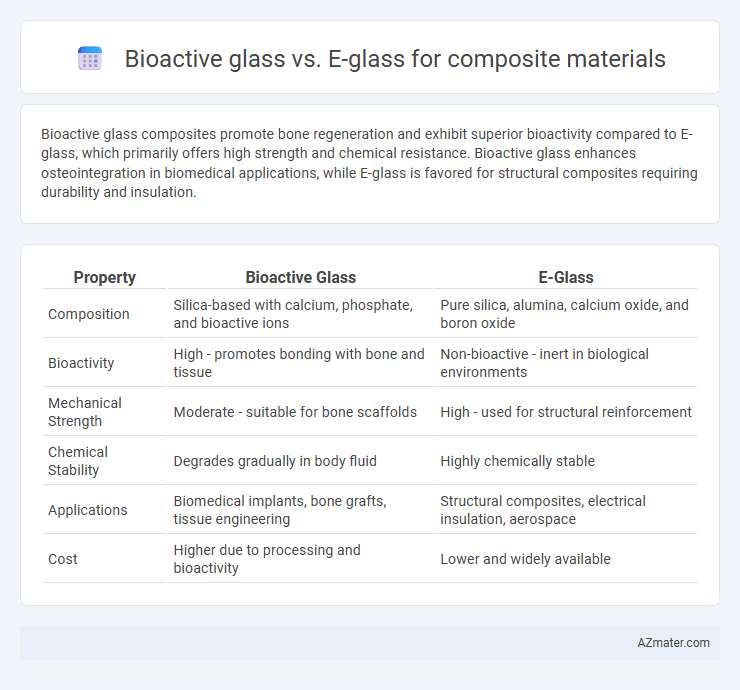Bioactive glass composites promote bone regeneration and exhibit superior bioactivity compared to E-glass, which primarily offers high strength and chemical resistance. Bioactive glass enhances osteointegration in biomedical applications, while E-glass is favored for structural composites requiring durability and insulation.
Table of Comparison
| Property | Bioactive Glass | E-Glass |
|---|---|---|
| Composition | Silica-based with calcium, phosphate, and bioactive ions | Pure silica, alumina, calcium oxide, and boron oxide |
| Bioactivity | High - promotes bonding with bone and tissue | Non-bioactive - inert in biological environments |
| Mechanical Strength | Moderate - suitable for bone scaffolds | High - used for structural reinforcement |
| Chemical Stability | Degrades gradually in body fluid | Highly chemically stable |
| Applications | Biomedical implants, bone grafts, tissue engineering | Structural composites, electrical insulation, aerospace |
| Cost | Higher due to processing and bioactivity | Lower and widely available |
Introduction to Composite Materials
Composite materials combine two or more distinct phases to achieve superior mechanical and functional properties compared to individual components. Bioactive glass, known for its excellent biocompatibility and ability to bond with bone tissue, enhances bioactivity in composites used for medical implants and tissue engineering. E-glass, widely utilized for its high tensile strength and cost-effectiveness, provides outstanding reinforcement in structural composites, making both materials essential depending on the application requirements.
What is Bioactive Glass?
Bioactive glass is a type of biomaterial composed primarily of silica, calcium oxide, and phosphorus pentoxide that interacts positively with biological tissues by forming a hydroxycarbonate apatite layer, promoting bone bonding and regeneration. Unlike E-glass, which is an aluminosilicate glass known for high strength and electrical insulation but bio-inert properties, bioactive glass actively supports cellular processes and tissue integration in composite materials used for medical implants. This bioactivity makes bioactive glass essential in orthopedic and dental composites, enhancing biocompatibility and facilitating tissue repair.
Understanding E-Glass: Properties and Uses
E-glass, a type of alumino-borosilicate glass reinforced with alkali oxides, exhibits high tensile strength, excellent electrical insulation, and chemical durability, making it a preferred reinforcement in composite materials. Its superior mechanical properties, resistance to heat, and cost-effectiveness have established E-glass as the standard for aerospace, automotive, and marine composites. Compared to bioactive glass, E-glass lacks bioactivity but offers enhanced structural integrity vital for load-bearing composite applications.
Bioactive Glass vs E-Glass: Chemical Composition
Bioactive glass contains silica (SiO2), calcium oxide (CaO), sodium oxide (Na2O), and phosphorus pentoxide (P2O5), which promote bone bonding and bioactivity, while E-glass primarily consists of silica, alumina (Al2O3), calcium oxide, and boron oxide (B2O3), designed for high mechanical strength and electrical insulation. The unique composition of bioactive glass facilitates hydroxyapatite layer formation essential for biomedical applications, unlike E-glass, which lacks this bioactivity due to its more stable and inert chemical structure. Differences in chemical components influence composite material properties such as bioactivity, biocompatibility, and mechanical performance in medical and structural uses.
Mechanical Properties Comparison
Bioactive glass composites exhibit higher bioactivity and promote bone bonding but generally have lower tensile strength and fracture toughness compared to E-glass composites. E-glass composites offer superior mechanical properties such as increased tensile strength, stiffness, and impact resistance, making them more suitable for load-bearing applications. The choice between bioactive glass and E-glass depends on balancing mechanical performance with biological integration requirements.
Bioactivity and Biological Response
Bioactive glass in composite materials promotes superior bioactivity by facilitating hydroxyapatite layer formation, enhancing bone bonding and regeneration. E-glass, primarily composed of alumino-borosilicate glass, offers excellent mechanical strength but lacks inherent bioactive properties, resulting in limited biological response. Consequently, bioactive glass composites support improved cellular adhesion and proliferation, making them ideal for bone tissue engineering applications.
Applications in Biomedical Engineering
Bioactive glass enhances bone regeneration and bonding in orthopedic and dental implants due to its bioactivity and ability to form hydroxyapatite, making it ideal for tissue engineering scaffolds and bone graft substitutes. E-glass fibers provide high mechanical strength and corrosion resistance, commonly used in prosthetics and load-bearing composite implants where structural integrity is critical. Combining bioactive glass with E-glass in composite materials offers a balance of bioactivity and mechanical durability for advanced biomedical applications.
Durability and Long-Term Performance
Bioactive glass exhibits superior bioactivity and chemical bonding with bone tissue but tends to have lower mechanical durability and long-term stability compared to E-glass composites. E-glass fibers provide enhanced mechanical strength, impact resistance, and environmental durability, making them more suitable for applications requiring prolonged structural integrity. For composite materials subjected to cyclic loading and harsh environments, E-glass offers better long-term performance, whereas bioactive glass is favored for biomedical applications prioritizing biointegration over mechanical longevity.
Cost and Manufacturing Considerations
Bioactive glass composites generally incur higher production costs due to complex synthesis processes and stricter quality controls compared to E-glass, which benefits from mature, cost-effective manufacturing techniques. E-glass fibers are widely available and easily integrated into composite matrices, reducing overall manufacturing time and expenses. The biodegradability and enhanced bioactivity of bioactive glass demand specialized handling and equipment, impacting scalability and cost-efficiency in large-scale composite production.
Future Trends in Composite Material Reinforcement
Bioactive glass exhibits superior osteoconductive properties and biodegradability compared to traditional E-glass, making it a leading candidate for bone tissue engineering applications in composite materials. Future trends emphasize the integration of bioactive glass nanoparticles with polymer matrices to enhance mechanical strength while promoting cell proliferation and healing. Advances in nano-fabrication and hybrid composite design are expected to drive the development of multifunctional materials with tailored bioactivity and optimized structural performance.

Infographic: Bioactive glass vs E-glass for Composite material
 azmater.com
azmater.com